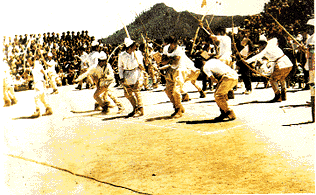| Cheibi Gad-Ga | |
| Kalari Payattu | |
| Silambam | |
| Thang-ta | |
| Thoda | |
| Thoda
The equipment required for this game are bows and arrows. Wooden bows measuring 1.5m to 2m, to suit the height of the archer and wooden arrows in proportion to the length of the bow, are prepared by skilled and traditional artisans. In Himachal Pradesh, in earlier days, the game of Thoda was organised in a very interesting way. A handful of village folk would go to another village, and would throw tree leaves into the village well, before sun rise. They would, then, hide in the bushes nearby, just outside the boundary of that village. As soon as the villagers came to draw water, the youths would shout, and throw challenges to them for a fight. This would spark the preparations for an encounter. The competition is a mixture of martial arts, culture and sport, and is held on Baisakhi Day, April 13 and 14, and community prayers are organised to invoke the blessings of the principal deities, Goddesses Mashoo and Durga. How the game is played Each group consists of roughly 500 people, but most of them are just dancers, who come along to boost the morale of their team. The archers are divided into parties, just before the competition takes place. One team is called Saathi, and the other Pashi. It is believed that Pashis and Saathis, are descendants of the Pandavas and Kauravas. The target in this game is the region of the leg, below the knee, where the opponent should aim his arrow. The moment the two contesting groups reach the village fairground, both the parties dance on either side of the ground, waving their swords, aglitter in the sun, and sing and dance to the stirring martial music. The Pashi group forms a 'chakravyuh', and blocks the Saathi group, who in turn begin to penetrate their defences. After the initial resistance, the Saathis reach the centre of the ground. Both the opponents face each other at a distance of about 10 metres, and prepare to attack. The defenders start shaking, kicking their legs to and fro with brisk movements, to thwart the accurate aim of their adversaries. Lightning movements and agility are the sole methods of defence. The whole competition is conducted to the lively, virile rhythm of war dance, with one side furiously side-stepping, legs kicking in all directions, and other side doing its best to place an arrow on the target. There are minus points for a strike on the wrong parts of the leg. At present, the game is played in a marked court, which ensures that a certain degree of discipline is maintained in Thoda - a happy blend of culture and sport. This game is popular in Theog Division (Shimla district), Narkanda block, Chopal Division, district Sirmaur and Solan. |
 Thoda,
the impressive martial art form of Himachal Pradesh, relies on one's
archery prowess, dating back to the days of the Mahabharata, when bows
and arrows were used in the epic battles, between the Pandavas and the
Kauravas, residing in the picturesque valleys of Kulu and Manali. Thus,
this martial art has its origin in Kulu. Thoda, the name is derived,
from the round piece of wood fixed to the head of the arrow, which is
used to blunt its wounding potential.
Thoda,
the impressive martial art form of Himachal Pradesh, relies on one's
archery prowess, dating back to the days of the Mahabharata, when bows
and arrows were used in the epic battles, between the Pandavas and the
Kauravas, residing in the picturesque valleys of Kulu and Manali. Thus,
this martial art has its origin in Kulu. Thoda, the name is derived,
from the round piece of wood fixed to the head of the arrow, which is
used to blunt its wounding potential.